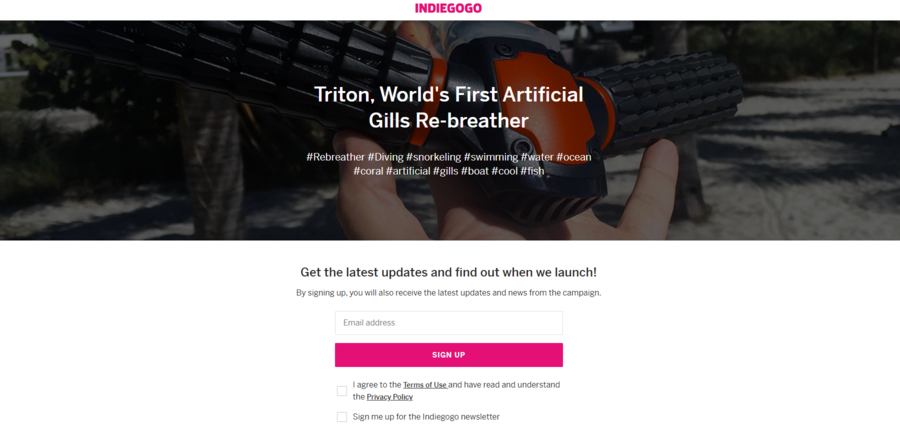
Did developers invent a device that allows divers to breathe underwater without the use of additional gear such as an air tank? No, that's not true: The device, called the Triton, is a prototype that was never launched as a product after experts expressed concerns over its viability. A crowdfunding campaign in 2016 that raised nearly $900,000 for the Triton was canceled and all of the money was reportedly refunded to investors.
Although news of the prototype broke in 2013 and the product crashed in 2016, the assertion that the prototype "will" work reappeared as a Facebook post (archived here) on April 3, 2021, by the Facebook interest page PokéVerse. The top caption says "A new scuba mask prototype, by Jeabyun Yeon, will allow humans to breathe underwater without the aid of an oxygen tank." The post continues:
The "Triton" mimics the gills on a fish to draw oxygen from the water supply.
A new scuba diving mask prototype, by Jeabyun Yeon, will allow humans to breathe underwater without the aid of an oxygen tank...
And thus, we become one step closer to the Pokemon world
This is what the post looked like on Facebook at the time of writing:
(Source: Facebook screenshot taken on Tue Apr 6 21:36:32 2021 UTC)
The PokéVerse page is dedicated to all things Pokémon, a Japanese manga media franchise launched in 1996 that contains a universe of collectible pocket monsters known as "Pokémon".
The post's caption alludes to one of the Pokémon named Squirtle and its capabilities. According to the United States Pokémon website, when Squirtle "retracts its long neck into its shell, it squirts out water with vigorous force."
Jeabyun Yeon, whose LinkedIn lists him as a senior designer at LIXIL, claimed to have designed the Triton as a part of a graduation exhibition at the Samsung Art and Design Institute in 2013. The prototype is described by Yeon as a "Portal Oxygen Respirator." A YouTube video published in 2014 by News Direct explains how the Triton supposedly works:
Called "Triton," the mask is a mouthpiece respirator that allows users to breathe underwater, simply by biting on the mouthpiece. The water is first sucked in by the mask's two arms. The oxygen is then extracted by a filter with fine threads and holes smaller than water molecules. The excess liquid is then released, while the oxygen is stored by a micro compressor. It acts like a fish's gill to extract oxygen from water so that the user can keep breathing while under the sea by simply wearing the mask. The compressor is powered by a micro battery, that is supposedly 30 times smaller than its contemporaries but charges a thousand times faster.
Alistair Dove, a marine biologist who currently serves as the vice president of science and education at the Georgia Aquarium, wrote a 2014 article for Deep Sea News that explained some of the reasons why the Triton prototype would not work:
...to supply you with oxygen at normal resting breathing rates, the Triton would need to filter 15 x 6L = 90L per minute, or about 24 gallons. For scale, 25 gallons a minute is about as much as a 1/4 horsepower sump pump pushes out, depending on static head. Without any kind of pump in the Triton to move water through the device, it relies on swimming (and presumably breathe suction?) to create the flow of water. There's too many variables in that, but let's just say you'd certainly have to swim so fast to supply the needs of 15bpm that you wouldn't be breathing 15bpm anymore.
Once the campaign for the Triton was launched and publicized, experts were concerned that the artificial gills were not sufficient in filtering out oxygen in water. After several other experts dismissed the possibility for the Triton to work as described, the campaign for the device was canceled. In a campaign statement and a video, both of which have since been deleted, the device's developers clarified that the product needed both its "artificial gills" and a "liquid oxygen" cylinder to operate effectively. DeeperBlue.com provided excerpts from the now-deleted statement from Triton which apparently stated:
Since launching we have been protecting our proprietary technology because it's so important to our success, but after careful consideration we think it's important to share these details and clarify how the device works. Inside of each Triton, the artificial gills utilize 'liquid oxygen', which combined with the other components allow users to breathe underwater, which you can see in the video above. We will release more information about the 'liquid oxygen' cylinders and safety strap.
Note that the 'liquid oxygen' cylinders won't last forever so we plan to make it possible for backers to purchase and exchange cylinders through our website. They will come in packs of 1, 3, and 5, and we'll list prices as soon as they are finalized. We're also working on a solution to make them refillable.
In an April 6, 2021, email to Lead Stories, Neal W. Pollock, an associate professor in Kinesiology at Université Laval and the former research director at Divers Alert Network, said that even if the liquid oxygen cylinders were implemented, they would not help make the Triton more effective:
The bottom line is that the proposed change is not reality-based, and if it were, it would not be safe physiologically. Liquid oxygen has a boiling point around -150C (-240F). It needs to be insulated from the warmer outside temperatures. There are more than a few challenges in making a small container that someone could simply wander around with. Even if these challenges could be overcome, the safety issues continue. Concentrated oxygen can also only safely be breathed at a shallow depth underwater. It would be fine to a depth around 6 m (20 ft), but the risk of central nervous system oxygen toxicity would increase with depth beyond that point.
Research by Pollock that was presented at the 2019 AAUS Diving for Science Symposium also discusses oxygen partial pressure, summarized here.
The idea of an artificial gill is not unique to the developers of Triton. In 2014, Arnold J. Landé was granted a patent for "Artificial gills for deep diving without incurring the bends and for scavenging O2 from and dispelling CO2 into water or thin air." Lead Stories could not locate evidence of a prototype for Landé's patent, but a prototype is not necessary to file a patent. An excerpt from the patent's abstract states:
The invention provides a system whereby oxygen can be derived from seawater or from thin air at higher altitudes while simultaneously eliminating carbon dioxide from the blood. This allows prolonged underwater liquid breathing at greater depths without suffering from the bends or, alternatively, the ability of workers to breathe underwater or at high altitudes without having to rely upon air tanks or the like.
More recently, Jun Kamei, a biomimicry designer and material scientist, collaborated with the RCA-IIS Tokyo Design Lab to design a 3-D printed artificial gill garment called Amphibio. However, Amphibio would require more surface if used by humans. The prototype's patent is pending.
Pollock said that no technology comparable in size to the Triton has been developed:
There is no comparable technology with the miniaturization they are promising. It takes a full rebreather system to control the partial pressure of oxygen effectively for real diving. The current minimal weight of these systems is (optimistically) 23 kg (50 lbs), and more realistically 32 kg (70 lbs). Added to this is the additional weight for bailout equipment (which can double the weight for technical dives). The miniature version is a product of 60s Bond moviemaking. It is science fiction. There is no foreseeable shortcut in getting there.
Lead Stories also reached out to the Professional Association of Diving Instructors to learn more about any developing technology with similar capabilities to the Triton and will update this story with any response.
As of now, the Indiegogo page for Triton is still active. However, it only allows interested parties to sign up for updates about when the product will launch. This is how the page appears at the time of writing:

















